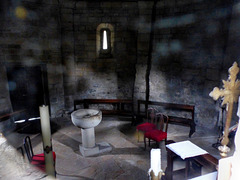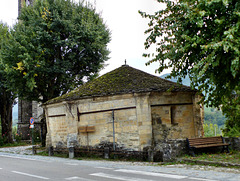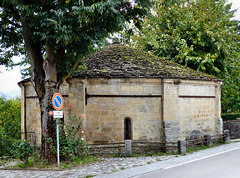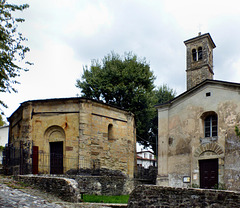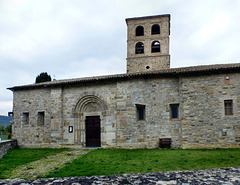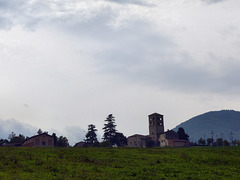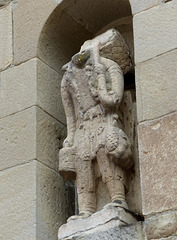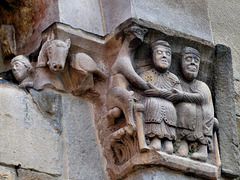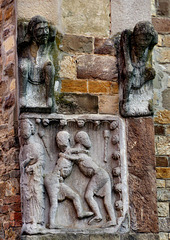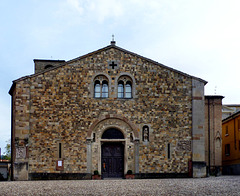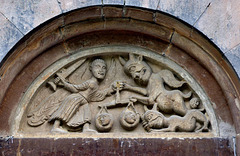
Italy
Photos taken in Italy (and Vatican State and San Marino).
Fidenza - Cattedrale di San Donnino
| |
|
|
|
In 1927, what is pretty recent, the city "Borgo San Donnino" changed it´s name to "Fidenza", as in Roman times it was known as "Fidentia Julia".
The city was named and the Duomo inside the walls was dedicated to San Donnino di Fidenza (aka "Domninus of Fidenza"), who was martyred nearby in 291.
Sigeric the Serious, Archbishop of Canterbury, made the pilgrimage to Rome following the Via Francigena around 990. His contemporary records of this journey still exist (and are source for the modern guide books). He reached "Sce Domnine" after 36 days, what is pretty fast for more than 1000kms.
The erection of the Cattedrale di San Donnino started in the 11th century, the first consecration took place in 1106, though the building process continued. From around 1200 on Master Benedetto Antelami and his workshop worked here, not only as Master masons. Antelami may as well be the architect of the facade.
Frederick Barbarossa had entrusted "Borgo San Donnino" to the Pallavicino family of Piacenza. In 1268 - after a siege - the city was conquered by the troops of Parma, who looted and burnt down it completely. All houses got destroyed at that time just the Duomo was saved, but it was not completed at that time. The building process came to a stop - and was never continued. Seen here is the duomo´s apse.
Fidenza - Cattedrale di San Donnino
| |
|
|
In 1927, what is pretty recent, the city "Borgo San Donnino" changed it´s name to "Fidenza", as in Roman times it was known as "Fidentia Julia".
The city was named and the Duomo inside the walls was dedicated to San Donnino di Fidenza (aka "Domninus of Fidenza"), who was martyred nearby in 291.
Sigeric the Serious, Archbishop of Canterbury, made the pilgrimage to Rome following the Via Francigena around 990. His contemporary records of this journey still exist (and are source for the modern guide books). He reached "Sce Domnine" after 36 days, what is pretty fast for more than 1000kms.
The erection of the Cattedrale di San Donnino started in the 11th century, the first consecration took place in 1106, though the building process continued. From around 1200 on Master Benedetto Antelami and his workshop worked here, not only as Master masons. Antelami may as well be the architect of the facade.
Frederick Barbarossa had entrusted "Borgo San Donnino" to the Pallavicino family of Piacenza. In 1268 - after a siege - the city was conquered by the troops of Parma, who looted and burnt down it completely. All houses got destroyed at that time just the Duomo was saved, but it was not completed at that time. The building process came to a stop - and was never continued.
The facade, seen here, is still not complete.
Serravalle - Pieve di San Lorenzo
| |
|
Serravalle (= narrow valley) is part of the larger Varano de' Melegari. The Via Francigena crossed the river Ceno nearby in medieval times.
A church was erected over the ruins of a Roman temple, dedicated to Diana, within the 10th century. This church was destroyed by an earthquake in the 14th century.
It is locally claimed, that the octagonal baptistery (left), to be the oldest structure in the Parma region dating back to the 8th century. It was more likely built in the 10th/11th century, when the church gained importance as "pieve".
The octagonal plan is very common for baptisteries (not only in Italy) is according to Saint Ambrogio the ideal plan for these buildings. The number "seven" represents life on earth (six days for the creation and the seventh for God´s rest). The "eight" stands for the life after the resurrection made possible through the baptism.
There are many ancient graffiti craved into the outside walls of the baptistery. Over the centuries, many pilgrims on their way to Rome (or back) left marks. These "soles" are typical for (walking) pilgrims. Pilgrims traveling one horseback (or mules) often left "horseshoe-graffiti", but I found no horseshoe here. Riders may have taken a different track.
Serravalle - Pieve di San Lorenzo
| |
|
Serravalle (= narrow valley) is part of the larger Varano de' Melegari. The Via Francigena crossed the river Ceno nearby in medieval times.
A church was erected over the ruins of a Roman temple, dedicated to Diana, within the 10th century. This church was destroyed by an earthquake in the 14th century.
It is locally claimed, that the octagonal baptistery (left), to be the oldest structure in the Parma region dating back to the 8th century. It was more likely built in the 10th/11th century, when the church gained importance as "pieve".
The octagonal plan is very common for baptisteries (not only in Italy) is according to Saint Ambrogio the ideal plan for these buildings. The number "seven" represents life on earth (six days for the creation and the seventh for God´s rest). The "eight" stands for the life after the resurrection made possible through the baptism.
The baptistery was locked, but I could peep though the window. The octagonal structure is still a baptistery.
Serravalle - Pieve di San Lorenzo
| |
|
|
Serravalle (= narrow valley) is part of the larger Varano de' Melegari. The Via Francigena crossed the river Ceno nearby in medieval times.
A church was erected over the ruins of a Roman temple, dedicated to Diana, within the 10th century. This church was destroyed by an earthquake in the 14th century.
It is locally claimed, that the octagonal baptistery (left), to be the oldest structure in the Parma region dating back to the 8th century. It was more likely built in the 10th/11th century, when the church gained importance as "pieve".
The octagonal plan is very common for baptisteries (not only in Italy) is according to Saint Ambrogio the ideal plan for these buildings. The number "seven" represents life on earth (six days for the creation and the seventh for God´s rest). The "eight" stands for the life after the resurrection made possible through the baptism.
Serravalle - Pieve di San Lorenzo
| |
|
|
Serravalle (= narrow valley) is part of the larger Varano de' Melegari. The Via Francigena crossed the river Ceno nearby in medieval times.
A church was erected over the ruins of a Roman temple, dedicated to Diana, within the 10th century. This church was destroyed by an earthquake in the 14th century.
It is locally claimed, that the octagonal baptistery (left), to be the oldest structure in the Parma region dating back to the 8th century. It was more likely built in the 10th/11th century, when the church gained importance as "pieve".
The octagonal plan is very common for baptisteries (not only in Italy) is according to Saint Ambrogio the ideal plan for these buildings. The number "seven" represents life on earth (six days for the creation and the seventh for God´s rest). The "eight" stands for the life after the resurrection made possible through the baptism.
Serravalle - Pieve di San Lorenzo
| |
|
|
Serravalle (= narrow valley) is part of the larger Varano de' Melegari. The Via Francigena crossed the river Ceno nearby in medieval times.
A church was erected over the ruins of a Roman temple, dedicated to Diana, within the 10th century. The church, seen today is younger, as the Romanesque structure was destroyed by an earthquake in the 14th century.
It is locally claimed, that the octagonal baptistery (left), to be the oldest structure in the Parma region dating back to the 8th century. It was more likely built in the 10th/11th century, when the church gained importance as "pieve". The baptistery survived the 14th-century-earthquake, that destroyed the neighbouring church.
Serravalle - Pieve di San Lorenzo
| |
|
Serravalle (= narrow valley) is part of the larger Varano de' Melegari, known for a race track. The Via Francigena crossed the river Ceno nearby in medieval times.
A church was erected over the ruins of a Roman temple, dedicated to Diana, within the 10th century. The baptistery (right) may have existed already at that time, as it is claimed to be the oldest structure in the Parma region. The church, seen today is younger, as the Romanesque structure was destroyed by an earthquake in the 14th century. The high campanile was added in 1927.
Bardone - Santa Maria Assunta
| |
|
A church, near an old Roman road, existed here probably during the 6th century. This road leads up to the Cisa Passand connects the Po plain with Tuscany. It was used by the Lombards and later became the Via Francigena. The large church, seen today, is known since 1004. It got modified in 1080 and 1220. Later it got enlarged and transformed a couple of times.
The church houses some extraordinary carvings from the old parish church of Fornovo, but it was locked - and I could find nobody in the hamlet, who could open it.
Santa Maria Assunta has an impressive side portal with this very strange tympanum. Little Jesus standing on his mother's knees blesses the onlooker, while Joseph (?) is reading a book.
Bardone - Santa Maria Assunta
| |
|
|
|
A church, near an old Roman road, existed here probably during the 6th century. This road leads up to the Cisa Passand connects the Po plain with Tuscany. It was used by the Lombards and later became the Via Francigena. The large church, seen today, is known since 1004. It got modified in 1080 and 1220. Later it got enlarged and transformed a couple of times.
The church houses some extraordinary carvings from the old parish church of Fornovo, but it was locked - and I could find nobody in the hamlet, who could open it.
Santa Maria Assunta has an impressive side portal.
Bardone - Santa Maria Assunta
| |
|
|
|
A church, near an old Roman road, existed here probably during the 6th century. This road leads up to the Cisa Passand connects the Po plain with Tuscany. It was used by the Lombards and later became the Via Francigena. The large church, seen today, is known since 1004. It got modified in 1080 and 1220. Later it got enlarged and transformed a couple of times.
The church houses some extraordinary carvings from the old parish church of Fornovo, but it was locked - and I could find nobody in the hamlet, who could open it.
These hunting scenes framing he facade´s window (see previous upload) may well come from Fornovo too. The hunt is watched over by an Agnus Dei.
Bardone - Santa Maria Assunta
| |
|
A church, near an old Roman road, existed here probably during the 6th century. This road leads up to the Cisa Passand connects the Po plain with Tuscany. It was used by the Lombards and later became the Via Francigena. The large church, seen today, is known since 1004. It got modified in 1080 and 1220. Later it got enlarged and transformed a couple of times.
The church houses some extraordinary carvings from the old parish church of Fornovo, but it was locked - and I could find nobody in the hamlet, who could open it.
Bardone - Santa Maria Assunta
| |
|
|
|
A church, near an old Roman road, existed here probably during the 6th century. This road leads up to the Cisa Passand connects the Po plain with Tuscany. It was used by the Lombards and later became the Via Francigena. The large church, seen today, is known since 1004. It got modified in 1080 and 1220. Later it got enlarged and transformed a couple of times.
The church houses some extraordinary carvings from the old parish church of Fornovo, but it was locked - and I could find nobody in the hamlet, who could open it.
Fornovo di Taro - Santa Maria Assunta
| |
|
A church may have been here since Langobardic times, it is documented since 854, when it was already "pieve". In the 11th century the church got rebuilt with three naves and three apses. Some decades later a large narthex was added, to give shelter to the many pilgrims. Subsequently it got integrated into the church.
Over the next centuries many enlargements and modifications were done. The bell-tower was added in 1302. Mid of the 18th century this was a Baroque church.
Between 1927 and 1942 a major renovation was undertaken, reverting the church and the facade to its Romanesque elements.
Many carvings are scattered over the facade, some of them are parts of a medieval pulpit, that was dismembered in the 18th century.
It is believed that this headless sculpture depicts a pilgrim on his way to Rome. He has some keys hanging from his belt, what is connected to the key of Saint-Peter. On the other hand, he is loaded with so much weight, that he may be as well a peddler, walking from door to door.
Fornovo di Taro - Santa Maria Assunta
| |
|
|
A church may have been here since Langobardic times, it is documented since 854, when it was already "pieve". In the 11th century the church got rebuilt with three naves and three apses. Some decades later a large narthex was added, to give shelter to the many pilgrims. Subsequently it got integrated into the church.
Over the next centuries many enlargements and modifications were done. The bell-tower was added in 1302. Mid of the 18th century this was a Baroque church.
Between 1927 and 1942 a major renovation was undertaken, reverting the church and the facade to its Romanesque elements.
Many carvings are scattered over the facade, some of them are parts of a medieval pulpit, that was dismembered in the 18th century. This capital is probably still "in situ", the former portal got bricked up.
Two dignities - and a large animal. To the left a rider on horseback.
Fornovo di Taro - Santa Maria Assunta
| |
|
|
A church may have been here since Langobardic times, it is documented since 854, when it was already "pieve". In the 11th century the church got rebuilt with three naves and three apses. Some decades later a large narthex was added, to give shelter to the many pilgrims. Subsequently it got integrated into the church.
Over the next centuries many enlargements and modifications were done. The bell-tower was added in 1302. Mid of the 18th century this was a Baroque church.
Between 1927 and 1942 a major renovation was undertaken, reverting the church and the facade to its Romanesque elements.
Many carvings are scattered over the facade, some of them are parts of a medieval pulpit, that was dismembered in the 18th century. Here are two atlantes - and wrestlers. The works have lost their context.
Fornovo di Taro - Santa Maria Assunta
| |
|
|
A church may have been here since Langobardic times, it is documented since 854, when it was already "pieve". In the 11th century the church got rebuilt with three naves and three apses. Some decades later a large narthex was added, to give shelter to the many pilgrims. Subsequently it got integrated into the church.
Over the next centuries many enlargements and modifications were done. The bell-tower was added in 1302. Mid of the 18th century this was a Baroque church.
Between 1927 and 1942 a major renovation was undertaken, reverting the church and the facade to its Romanesque elements.
Many carvings are scattered over the facade, some of them are parts of a medieval pulpit, that was dismembered in the 18th century.
Talignano - San Biagio
| |
|
|
|
Erected by monks of a near Cistercian abbey in the 12th century, the church, as well as the (lost) "hopital" served the pilgrims, that walked the Via Francigena to Rome (and back home). It was modified over the centuries, but a renovation in the 1930 brought back the Romanesque structure, that it was originally.
San Biagio has an extraordenary tympanum.
Seen is the "Weighing of souls" (= Psichostasia). Saint Michael weighs the souls in a scale the good and bad deeds, while the devils intervenes, using trickery to make the scale fall on his side and take the soul to Hell. Small heads symbolize the souls. On the left side of the scale seems to be the soul of a monk (tonsur). The soul on the far right - is already on the way to eternal damnation.
The Weighing of Souls can often be found in France cand Spain along the "caminos" to Santiago de Compostella, but is not that often in Italy.
Sergio Stocchi ("Italia romanica"), attributes this work to the workshop of Benedetto Antelami and dates it to the end of the 12th century.
Jump to top
RSS feed- Latest items - Subscribe to the latest items added to this album
- ipernity © 2007-2024
- Help & Contact
|
Club news
|
About ipernity
|
History |
ipernity Club & Prices |
Guide of good conduct
Donate | Group guidelines | Privacy policy | Terms of use | Statutes | In memoria -
Facebook
Twitter




